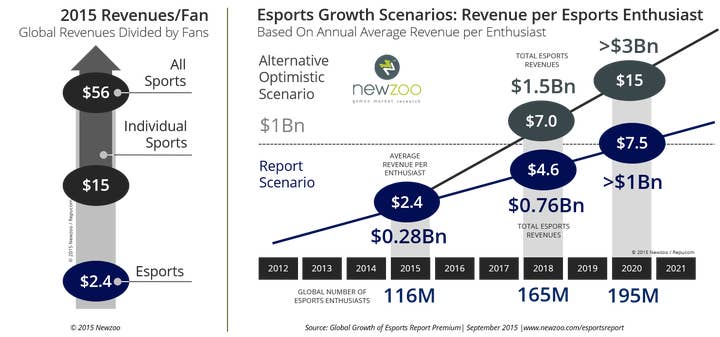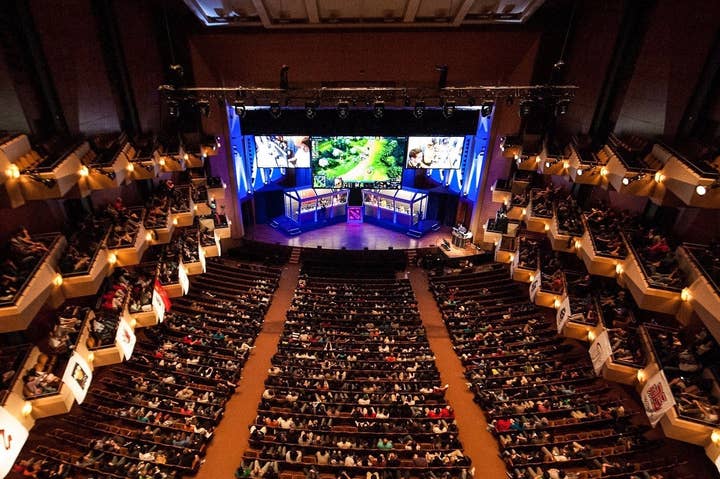Five factors key to making eSports a $1bn business by 2020
Newzoo lays out a roadmap for competitive gaming's growth
Over the last few years, competitive gaming has made huge strides, building a massive fanbase, supporting the rise of entire genres of games and attracting vast prize pots for the discipline's very best. Almost across the board, the phenomenon has also seen its revenues gaining, as new sponsors come on board, including some major household names. Sustaining the rapidity of the growth of eSports is going to be key to its long term success, maintaining momentum and pushing it ever further into the public consciousness.
In order to do that, according to Newzoo, eSports need to learn some lessons from their more traditional athletic counterparts. Right now, the research firm puts a pin in eSports revenues of $2.40 per enthusiast per year, a number which is expected to bring the total revenue for the industry to $275 million for 2015 - a 43 per cent increase on last year. By 2018, the firm expects that per user number to almost double, reaching $4.63.
That's a decent number, representing very rapid growth, but it pales in comparison to Newzoo's estimates on the average earning per fan for a sport like Basketball, which represents a $14 per fan revenue - rising to $19 where only the major league NBA is a factor. To catch up to numbers like this is going to take some time, but Newzoo's research has listed five factors it considers vital to achieving that aim.
Diversity
Right now, MOBAs are undeniably the king of the eSports scene, and one of the biggest genres in gaming. The king of MOBAs, League of Legends, is the highest earning game in the world, whilst others like Valve's DOTA 2 are also represent huge audiences and revenues, including the prestigious annual International tournament. Shooters are also still big business here, with Activision Blizzard recently announcing the formation of a new Call of Duty League.
Nonetheless, MOBAs are still the mainstay and if you don't like them, you're not going to get too deeply into competitive gaming as a fan. Although their popularity with the athletes is going to make them a difficult genre to shift, Newzoo says that broadening the slate is a key factor to growth.
Geographic reach
The major tournaments bring players, and audiences, from all over the world, but it's often only the very top tier of players who can find themselves a foothold in regular competition. Major territories like the US, South Korea and Europe have some local structure, but again League of Legends stands almost alone in its provision of local infrastructure. By expanding a network of regular leagues and competitions to more countries, eSports stands a much better chance of building a grassroots movement and capturing more fans.

Regulation
Already a problem very much on the radar of official bodies and players around the world, the introduction of regulation is always a tough transition for any industry. However, when you're putting up millions of dollars in prize money, you can't have any grey areas around doping, match fixing and player behaviour at events. These young players are frequently thrust into a very rapid acceleration of lifestyle, fame and responsibility - a heady mixture which can prove to be a damaging influence on many. Just like in other sports, stars need protecting and nurturing - and the competitions careful monitoring - in order for growth to occur without scandal and harm to its stars.
Media rights
Dishing out the rights to broadcast, promote and profit from eSports is a complex issue. Whilst games like football are worldwide concerns, with media rights a hotly contested and constantly shifting field, nobody owns the games themselves. With eSports, every single aspect of the games being played is a trademark in itself, with its owners understandably keen to protect them. However, with fan promotion such a key part of the sport's growth, and services like Twitch a massive factor in organic promotion, governing the rights of distribution is only going to become a murkier and more complex business as time goes on. With major TV networks, well used to exclusivity, now starting to show an interest, expect this to become a hot topic.
Conflict between new and old media
That clash of worlds, between the fresh and agile formats of digital user-sourced broadcasting and the old network model is also going to be source of many of its own problems. One or the other, or even both, is going to have to adapt fast for there to be a convivial agreement which betters the industry as a whole. There's currently considerable pushback from established media against the idea of eSports becoming accepted as a mainstream activity, fuelled in no small part by their audiences themselves, so a lo of attitudes need to change. Add to that the links between these media giants and many of the world's richest advertisers and you can start to see the problem.

